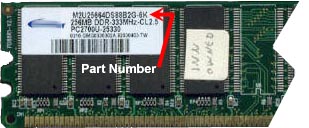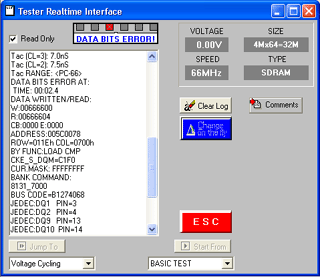Of course, the first thing you need to do is test the suspect module to confirm that it is faulty. This takes just a few seconds with RAMCHECK.
If the module is OK, RAMCHECK will quickly identify the module's speed, size & type, and give a pass/fail message. If RAMCHECK has confirmed that the module is faulty, you will need to retrieve the data sheet from the manufacturer. This is easier than you may think, even for old modules.
First, find the manufacturer & the part number of the module. A small white label should be affixed to the module which includes the part number, and the manufacture
 r's name should be printed on the PCB (see figure A ). Next, go to the manufacturer's web site. (If you don't know what the URL is, type the company name into the search box at google or yahoo. Most manufacturers allow you to search by part number. If not, by selecting the right product categories you should be able to quickly navigate your way to the correct data sheet, which is typically a PDF file. Still not having luck finding it? Search for the part number on google or yahoo. The data sheets may no longer be linked from the company's web site, but the search engines may still have the link in their archives. If all else fails, you can use a continuity meter from the pin identified by RAMCHECK to find the connected chip.
r's name should be printed on the PCB (see figure A ). Next, go to the manufacturer's web site. (If you don't know what the URL is, type the company name into the search box at google or yahoo. Most manufacturers allow you to search by part number. If not, by selecting the right product categories you should be able to quickly navigate your way to the correct data sheet, which is typically a PDF file. Still not having luck finding it? Search for the part number on google or yahoo. The data sheets may no longer be linked from the company's web site, but the search engines may still have the link in their archives. If all else fails, you can use a continuity meter from the pin identified by RAMCHECK to find the connected chip.
Now that you know where the defective chip is you'll have to replace it. Only a technician with component-level repair expertise can repair a memory module. The required soldering/ desoldering equipment is relatively complex, especially with modules & cards made with extremely thin Surface Mount technology (i.e., devices with TSOP chips). You will need a good deal of practice with desoldering techniques. Nevertheless, a few minor problems, which are identified by RAMCHECK, can be repaired with simple tools. A short between an adjacent pin may be caused by a small piece of metallic debris, which is stuck between two chips. You "repair" the module in this case with an Exacto knife or a watchmaker's fine screwdriver by simply removing the debris. If you use RAMCHECK in the production shop, you should be able to easily replace the module's components.
Repairing memory does involve a fair amount of work, but as companies around the world have discovered with RAMCHECK, it can be a lucrative business.

No comments:
Post a Comment